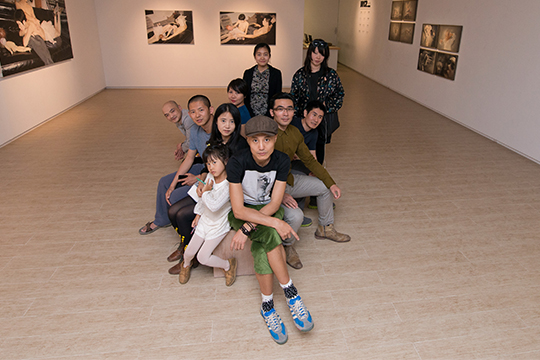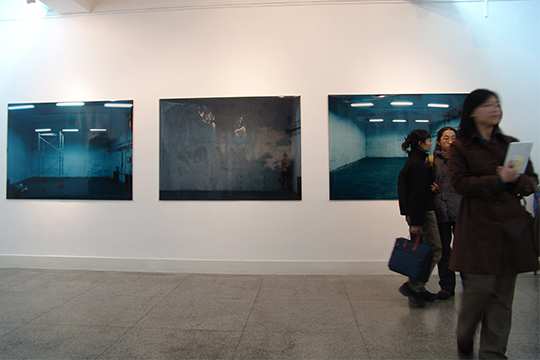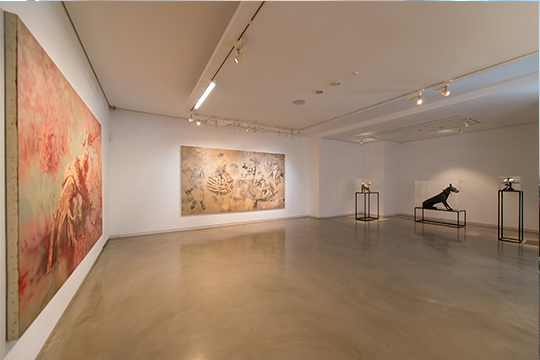N12: FIFTH TIME’S A CHARM
| July 16, 2014 | Post In LEAP 27

2007 was a busy year for Chinese contemporary art. Looking back, many events of that year resonate today. It was the year that Forbes published an analysis of the five hottest collectible commodities; impressively, contemporary Chinese art came top of the list. It was also the year that the members of the young artists’ collective N12, which had already held four group exhibitions and was extremely well known in Beijing, decided, after extensive discussions, to put an end to their shows. As for when or whether they would work together again: “We will leave it to the future– at the moment we don’t yet know.” Between 2003 and 2006, N12 had relied entirely on themselves to gather the resources needed to mount their four exhibitions. As of the third exhibition they were privately funded, and for the fourth exhibition they moved from the Central Academy of Fine Arts to the newly opened C5 Gallery in Sanlitun. In their own words, stopping their shows at that time felt like “swimming against the tide.”
By the time of N12’s fourth exhibition, “N12 No. 4,” Beijing’s art market was expanding rapidly, galleries were opening up, and outside influences were filtering in. What had originally been a simple group show was affected by these changes. Wang Guangle had always been very aware of the self-governing nature of the group. In an interview he said: “In painting, where the trends change more slowly, exhibiting as frequently as once a year is actually quite a fast pace. I think we should take a break, or wait until we find a more suitable way forward before continuing.” For many of the others, it was more the case that their individual careers were developing such that they had opportunities for other exhibitions or solo shows, which for them lessened the value of the N12 shows. From an entry by Wen Ling on N12’s blog on August 4, 2006, titled “Revitalize N12,” it was evident that the comings and goings of members—and how to continue organizing exhibitions—had become pressing issues for them, but the former seemed a bigger concern.

However, there is no doubt that N12 also made an effort to protect their friendships (the basis on which the group had been founded) and to not let the group become an empty shell—art, after all, requires the greatest individuality. These efforts and experiences became themselves an “experimental ground” for “self-organizing” in contemporary Chinese art. In a city like Beijing, which changes so quickly, a seven-year pause is almost equivalent to the time it takes for a district to be built up or torn down. Discussions and personal interactions continued, with the result that in the winter of 2013, “N12 No. 5” was held at Beijing Commune, and “N12 No. 6” at Lin & Lin Gallery in Taipei in April, 2014. The biggest difference in this re-formed group may be that when they first started, N12 was more clearly consciously self-organized, with the group allowing members to pursue maximum individual benefits, creating mutual reliance and a belief in the intrinsic value of the group itself. Wang Guangle expressed it well: “When we founded N12, the aims were clear: we needed to increase our chances to exhibit and get exposure. As time passed, each member’s career got on track. For the fifth show, we wanted to give the public a different small group show and present a different face.”

What kind of different face? In these two shows we can see a great deal of change in the work of the N12 members. No longer focused on the concerns of fresh graduates—the fight for survival and to find their unique style—instead, they are mature artists exploring the nature of art itself. Most of N12 started out with painting, which at that time faced a number of challenges. Indeed, the artists’ self-aware explorations through painting were at the heart of the first four exhibitions. For the fifth show, Wang Guangle, Hu Xiaoyuan, Qiu Xiaofei, and Yang Jing brought installations far removed from their general painting practice, Song Kun has enhanced her command of the picture plane, Wang Jie continued to paint but through the use of mixed , the canvas took on a different significance, Ma Yanhong expanded her early study of feminist thought, the body, and gender to include a social dimension, while illuminating the picture plane through increasingly refined brushwork; and Wen Ling delved deeper into comics and oil painting, blurring the boundaries between the two to bring out different aspects of both in an expressionist style remarkable in its study of color. Moreover, while in the beginning only Wang Guangle was making abstract art, now almost half of the members have started to move away from figurative forms, challenging the accepted boundaries of consciousness in abstraction. The critic Bao Dong has correctly pointed out that this distancing and abstraction represents a collective stance about the realism taught in art school. The process of finding one’s vision in an abstraction of art history in that it is more about individuality. Qiu Xiaofei’s works are a typical example of this.

Perhaps we should think of the present N12 as a new collective. Exhibiting is no longer the goal, but a mature window through which to see the self-governing reality of Chinese contemporary art. We can think of N12 as an art community that looks like a small collective, operates through annual exhibitions, and records the evolution of Chinese contemporary art. Each member’s artworks have value vertically for individual in-depth view and study, while horizontally, they can show us a cross-section of an art system centered on Beijing. It is not improbable that in the future N12 will face a wider international perspective, carrying on as a group with differences in their own geographical and individual characteristics. We look forward to N12’s next ten years.

